<invoke>
Invokes an operation on a partner link web service.
<invoke partnerLink="NCName"
portType="QName"?
operation="NCName"
inputVariable="BPELVariableName"?
outputVariable="BPELVariableName"?
standard-attributes>
standard-elements
<correlations>?
<correlation set="NCName" initiate="yes|join|no"?
pattern="request|response|request-response"? />+
</correlations>
<catch faultName="QName"?
faultVariable="BPELVariableName"?
faultMessageType="QName"?
faultElement="QName"?>*
activity
</catch>
<catchAll>?
activity
</catchAll>
<compensationHandler>?
activity
</compensationHandler>
<toParts>?
<toPart part="NCName" fromVariable="BPELVariableName" />+
</toParts>
<fromParts>?
<fromPart part="NCName" toVariable="BPELVariableName" />+
</fromParts>
</invoke>
Example:
<invoke partnerLink="Ordering"
portType="ord:OrderPT"
operation="ConfirmOrder"
inputVariable="Order"
outputVariable="OrderConf" />
<receive>
Waits for an incoming message (operation invocation). Typical uses: first process activity (createInstance="yes"); to wait for callbacks.
<receive partnerLink="NCName"
portType="QName"?
operation="NCName"
variable="BPELVariableName"?
createInstance="yes|no"?
messageExchange="NCName"?
standard-attributes>
standard-elements
<correlations>?
<correlation set="NCName" initiate="yes|join|no"? />+
</correlations>
<fromParts>?
<fromPart part="NCName" toVariable="BPELVariableName" />+
</fromParts>
</receive>
Example:
<receive partnerLink="Ordering"
portType="ord:OrderCallbackPT"
operation="confirmOrder"
variable="OrderConfirmation"/>
<pick>
Waits for one of several possible messages (operation invocations) or for a time-out.
<pick> can be the first process activity (createInstance="yes", no <onAlarm> allowed).
<pick createInstance="yes|no"? standard-attributes>
standard-elements
<onMessage partnerLink="NCName"
portType="QName"?
operation="NCName"
variable="BPELVariableName"?
messageExchange="NCName"?>+
<correlations>?
<correlation set="NCName" initiate="yes|join|no"? />+
</correlations>
<fromParts>?
<fromPart part="NCName" toVariable="BPELVariableName" />+
</fromParts>
activity
</onMessage>
<onAlarm>*
(
<for expressionLanguage="anyURI"?>duration-expr</for>
|
<until expressionLanguage="anyURI"?>deadline-expr</until>
)
activity
</onAlarm>
</pick>
Example:
<pick>
<onMessage partnerLink="Ordering"
portType="ord:OrderPT"
operation="confirmOrder"
variable="OrderConfirmation">
...
</onMessage>
<onMessage partnerLink="Ordering"
portType="ord:OrderPT"
operation="cancelOrder"
variable="OrderCancelation">
...
</onMessage>
<onAlarm>
<for>'PT12H'</for>
<!-- Order completion timed out -->
</onAlarm>
</pick>
<reply>
Sends a response for a request-response operation (synchronous). The request is received using either <receive>, <onMessage>, or <onEvent>.
<reply partnerLink="NCName"
portType="QName"?
operation="NCName"
variable="BPELVariableName"?
faultName="QName"?
messageExchange="NCName"?
standard-attributes>
standard-elements
<correlations>?
<correlation set="NCName" initiate="yes|join|no"? />+
</correlations>
<toParts>?
<toPart part="NCName" fromVariable="BPELVariableName" />+
</toParts>
</reply>
Example:
<reply partnerLink="Ordering"
portType="ord:OrderPT"
operation="placeOrder"
variable="Order"/>
<wait>
Waits for a specified time period or until a certain deadline.
<wait standard-attributes>
standard-elements
(
<for expressionLanguage="anyURI"?>duration-expr</for>
|
<until expressionLanguage="anyURI"?>deadline-expr</until>
)
</wait>
Example:
<wait>
<until>'2010-03-18T20:00+01:00'</until>
</wait>
<exit>
Immediately ends the BPEL process instance.
<exit standard-attributes>
standard-elements
</exit>
Example:
<exit/>
<empty>
This activity does not do anything. It is useful for synchronization of concurrent activities.
<empty standard-attributes>
standard-elements
</empty>
Example:
<empty/>
deadline-expr
Used in until expression of <onAlarm> and <wait>. XML Schema date or dateTime types are used to express deadlines (following ISO 8601).
<until>'2010-01-01'</until>
<until>'2010-03-18T21:00:00+01:00'</until>
<until>'18:05:30Z'</until>
duration-expr
Used in for expression of <onAlarm> and <wait>, and <repeatEvery> expression of <onAlarm>. XML Schema duration type is used (following ISO 8601).
<for>'PT4H10M'</for>
<for>'P1M3DT4H10M'</for>
<for>'P1Y11M14DT4H10M30S'</for>
| P |
Time duration designator. Duration expressions always start with P. |
| Y |
Follows the number of years. |
| M |
Follows the number of months or minutes. |
| D |
Follows the number of days. |
| H |
Follows the number of hours. |
| S |
Follows the number of seconds. |
| T |
Date-Time separator |



{{ parent.title || parent.header.title}}
{{ parent.tldr }}
{{ parent.linkDescription }}
{{ parent.urlSource.name }}